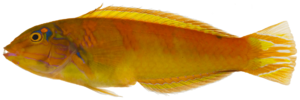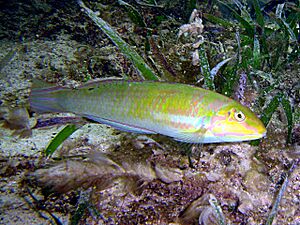Blackear wrasse facts for kids
Quick facts for kids Blackear wrasse |
|
|---|---|
 |
|
| Terminal male color phase | |
| Conservation status | |
| Scientific classification | |
| Synonyms | |
|
The blackear wrasse (Halichoeres poeyi) is a colorful fish that lives in the ocean. It belongs to a family of fish called wrasses. You can find it in the warm waters of the western Atlantic Ocean.
Contents
What Does the Blackear Wrasse Look Like?

The blackear wrasse has a long, thin body. It has a large eye and a pointed snout. Its mouth is at the very end of its snout. It also has teeth that stick out, like small fangs. Its fins near its chest, called pectoral fins, reach all the way to its belly.
This fish is very colorful! Its head and body are mostly olive green. Its scales have pinkish-red lines. It has wide pink bands and a thin blue stripe on its head and tail. There is a dark spot right behind its eye. This spot is why it's called the "blackear" wrasse.
The top fin, called the dorsal fin, has blue and orange edges. Its tail fin, or caudal fin, is a dull yellow. It has blue and rose lines that cross each other. There is also another black spot on its back, near the start of its dorsal fin.
Male and female blackear wrasses look similar. However, males are usually bigger than females. This fish can grow to about 20 centimeters (about 8 inches) long.
Where Does the Blackear Wrasse Live?
The blackear wrasse lives in the western Atlantic Ocean. You can find it from southern Florida and the Bahamas. Its home stretches all the way down to Santa Catarina in southern Brazil.
How the Blackear Wrasse Lives
Blackear wrasses live in different ocean habitats. They can be found in coral reefs and rocky areas. They also like to live in seagrass beds, especially where there is turtle grass. They usually live in waters up to 30 meters (about 100 feet) deep. You might also see them in places with lots of algae.
These fish are active only during the day. At night, they become very slow and sleepy. They mostly eat small ocean animals without backbones. These include crabs, snails, sea stars, and sea urchins. Sometimes, they might eat sea urchins that have already been attacked by bigger fish.
Reproduction and Life Cycle
The blackear wrasse has an interesting way of reproducing. Every single blackear wrasse starts its life as a female. As they grow bigger, some of these females change into males. This usually happens when they are about 8.3 centimeters long.
Male blackear wrasses gather in special areas called "leks." Here, they put on a show to attract females. This is quite unusual for wrasses, as most other species have males that form groups with many females, called harems.
When blackear wrasses are very young, they are called larvae. These larvae are long and thin. They have small mouths and small fins near their bellies. The blackear wrasse is special because its larvae develop unique colored cells inside their bodies.
Blackear Wrasse and People
The blackear wrasse is a small fish. Because of its size, it is not usually caught for food by big fishing companies. However, it is sometimes caught to be sold as a pet fish for aquariums.
In Brazil, there are rules about how many of these fish can be caught. Since 2004, companies that catch blackear wrasses for the aquarium trade can only catch 1,000 fish per year. This helps protect the fish population.
Naming the Blackear Wrasse
The blackear wrasse was first officially described in 1867. It was named by an Austrian scientist named Franz Steindachner. The second part of its scientific name, poeyi, honors a Cuban scientist named Felipe Poey. He had described a similar type of fish in 1860.


